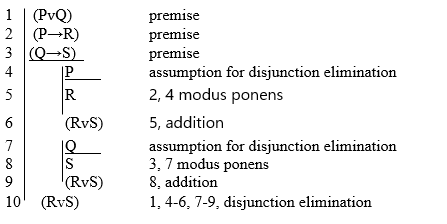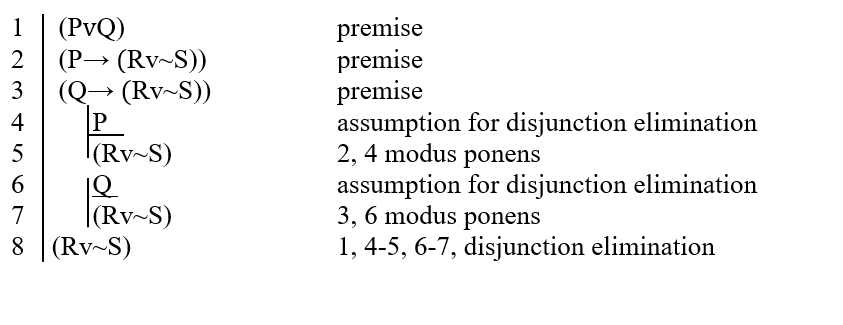Chapter 7 Answer Key
7.7 Exercises
A. Exercises: Or Truth Tables. The Disjunction. Fill out the truth table for the following disjunctions.
-
P Q (P v Q) T T T T T T F T T F F T F T T F F F F F -
P Q (Q v P) T T T T T T F T T F F T F T T F F F F F
B. Exercises: Truth Table Logical Equivalence. Determine whether each pair of sentences is logically equivalent. Justify your answer with a complete truth table.
-
A B (A v B) T T T T T T F T T F F T F T T F F F F F -
A B (B v A) T T T T T T F T T F F T F T T F F F F F -
P (P → P) (P v P) T T T T T T T F F T F F F F Look at the main logical connectives, conditional and disjunction. We can see that on every row, they have the same truth value, so they are logically equivalent.
-
P (P & P) (P v P) T T T T T T T F F F F F F F Look at the main logical connectives, conjunction and disjunction. We can see that on every row, they have the same truth value, so they are logically equivalent.
-
P Q (P v ~ Q) (~ P v Q) T T T T F T F T T T T F T T T F F T F F F T F F F T T F T T F F F T T F T F T F Look at the main logical connectives, both disjunctions. We can see that they do not have the same truth value on every row, so they are not logically equivalent.
-
P Q (P & ~ P) (~ Q v Q) T T T F F T F T T T T F T F F T T F T F F T F F T F F T T T F F F F T F T F T F Look at the main logical connectives, conjunction and disjunction. We can see that they do not have the same truth value on every row, so they are not logically equivalent.
-
P Q (P & ~ P) ~ (~ Q v Q) T T T F F T F F T T T T F T F F T F T F T F F T F F T F F F T T T F F F F T F F T F T F Look at the main logical connectives, conjunction and disjunction. We can see that on every row, they have the same truth value, so they are logically equivalent.
-
P Q ~ (P & Q) (~ P v ~ Q) T T F T T T F T F F T T F T T F F F T T T F F T T F F T T F T F T F F T F F F T F T T F Look at the main logical connectives, conjunction and disjunction. We can see that on every row, they have the same truth value, so they are logically equivalent.
-
P Q R ((P v Q) & R) (P v (Q & R)) T T T T T T T T T T T T T T T F T T T F F T F T F F T F T T T T T T T F F F T T F F T T F F F T F F F F F T T F T T T T F F T T T F T F F T T F F F F T F F F F T F F F F T F F F F T F F F F F F F F F F F F F Look at the main logical connectives, conjunction and disjunction. We can see that they do not have the same truth value on every row, so they are not logically equivalent.
C. Exercises: Translation and Proofs Using “Or”. Use the following translation keys to translate the passage into our propositional logic. Prove the argument is valid.
- Premises: (K v B), (K→I), (B→D), (D→W), ~W. Conclusion: K

(Notice that we have not used all the premises of the argument in this proof.) - Premises: (W v M), (M→ B), (L→~B). Conclusion: (L→W)

D. Exercises: Proofs. Prove the following arguments are valid.
- Premises: (PvQ), (Q→S), (~S&T). Conclusion: (T&P)

- Premises: ((P→~Q)&(R→S)), (Q v R). Conclusion: (P→S)

- Premises: (RvS), ((S→T)&V), ~T, ((R&V)→P). Conclusion: (PvQ)

- Premises: ((P&Q) v R), ((P&Q)→S), ~S. Conclusion: R

- Conclusion: ((PvQ)→(~P→Q)). (Note: this is a theorem)

- Premises: (PvQ) (P→R) (Q→S). Conclusion: (RVS)

- Premises: (PvQ), (P→ (Rv~S)), (Q→ (Rv~S)). Conclusion: (Rv~S)


